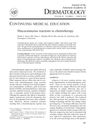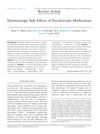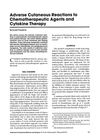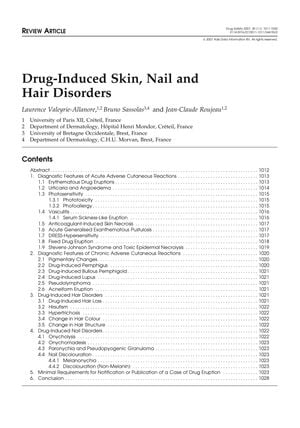TLDR Some drugs can cause skin, nail, and hair problems, which are important for healthcare professionals to recognize and report.
The document from 2007 reviews the significant health issue of drug-induced skin, nail, and hair disorders, affecting approximately 3% of hospitalized patients. It categorizes these reactions into acute and chronic types, with acute reactions including erythematous drug eruptions, urticaria, angioedema, photosensitivity, vasculitis, Stevens-Johnson syndrome, and toxic epidermal necrolysis, and chronic reactions presenting as dermatological diseases like pigmentary changes, autoimmune diseases, and acneiform eruptions. The review also discusses hair and nail disorders, such as hair loss, changes in hair color or structure, and various nail changes. It emphasizes the importance of clinical recognition, understanding the pathophysiology, and treatment of these adverse reactions, and the necessity for healthcare professionals to report these incidents. Drug-induced alopecia is highlighted as difficult to diagnose, with improvement upon drug discontinuation being a key indicator. The document also stresses the need for precise documentation and reporting of drug eruptions to pharmacovigilance surveillance centers to avoid bias in risk evaluation.
 275 citations
,
March 1999 in “Journal of The American Academy of Dermatology”
275 citations
,
March 1999 in “Journal of The American Academy of Dermatology” Chemotherapy can cause various skin reactions, with hair loss being the most common, and proper diagnosis and treatment of these reactions are important.
 63 citations
,
March 1995 in “International Journal of Dermatology”
63 citations
,
March 1995 in “International Journal of Dermatology” Some drugs can cause hair loss, and stopping these drugs often leads to hair regrowth.
 147 citations
,
April 1994 in “Drug Safety”
147 citations
,
April 1994 in “Drug Safety” Some drugs can cause hair loss or increase hair growth, but these effects are usually reversible when the drug is stopped.
 44 citations
,
January 2002 in “American Journal of Clinical Dermatology”
44 citations
,
January 2002 in “American Journal of Clinical Dermatology” Skin reactions to antidepressants are common but usually not serious and can be treated.
 47 citations
,
January 2003 in “American Journal of Clinical Dermatology”
47 citations
,
January 2003 in “American Journal of Clinical Dermatology” Mood stabilizers can cause serious skin reactions; careful monitoring and immediate treatment are crucial.
 12 citations
,
June 2003 in “Journal of the European Academy of Dermatology and Venereology”
12 citations
,
June 2003 in “Journal of the European Academy of Dermatology and Venereology” Some psychoactive drugs can cause skin reactions, with carbamazepine having a higher risk, and stopping the drug and seeing a dermatologist is important.
 31 citations
,
October 2013 in “Psychosomatics”
31 citations
,
October 2013 in “Psychosomatics” Psychotropic medications can cause skin reactions, including severe conditions like SJS and TEN, and it's important for psychiatrists to recognize and manage these side effects.
 18 citations
,
December 1996 in “Seminars in Cutaneous Medicine and Surgery”
18 citations
,
December 1996 in “Seminars in Cutaneous Medicine and Surgery” Chemotherapy and cytokine therapy can cause various skin reactions, including hair loss and hypersensitivity.









